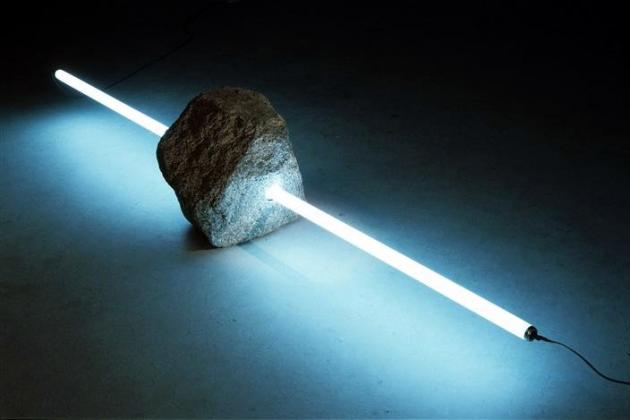Simon Lee Gallery presents ‘Five Decades: Sculpture and Works on Paper: Koji Enokura, Noriyuki Haraguchi, Tatsuo Kawaguchi, Noboru Takayama’. The exhibition brings together the work of four crucial figures whose early practices are affiliated with the post-war Japanese artistic phenomenon Mono-ha (School of Things). Spanning a period of five decades, the works on display examine the different artistic tendencies that developed out of the lineage of Mono-ha, highlighting overall the importance of this movement in creating a unique Japanese post-modern aesthetic.
Mono-ha is the name given to a group of artists working in Japan in the late 1960s and early 1970s. These artists are linked by a common desire to create relationships between man and matter, people and things, the industrial and the natural. Working with everyday “things” such as glass, stone, steel, rope, iron, wood, and oil, these artists sought to go beyond the materiality of the work and the physicality of things, to discover new worlds within. As Mono-ha was not a formal art group bound together by a set of doctrines, this allowed for inevitable changes in expression amongst its artists to develop. After 1971, and the decades following, artists cultivated within this loose-knit community began to go their separate ways. Some artists continued to develop the same tendencies associated with their early practices while others completely broke out of the Mono-ha sphere.
Working in numerous modes of expression and with a variety of materials, Tatsuo Kawaguchi (b. 1940) is consistent in his approach to matter and subject, and his desire to reveal the inner life of materials. Stone and Light no. 4 (1989), first conceived in 1971, counter-poses a natural stone with the light of a fluorescent lamp. Reminiscent of a Mono-ha interest in man and matter, two materials that seemingly have no relationship to one another are forged together resulting in a striking work of art. The COSMOS works (1974-1975) also included in the exhibition, take the idea of creating new relationships one step further by developing a link between the viewer and the past. Adopting the language of conceptual art and using astrophotography, Kawaguchi carefully writes numbers next to the stars documenting the moment when light left them to come to earth and in turn creates a dialogue with the past and the unseen.
Noriyuki Haraguchi (b. 1946) works in a more industrial and pared-down idiom than that of his contemporaries, veering towards a related Minimal vocabulary. The artist’s polyurethane paintings epitomize his desire to favour industrial materials over the natural, while also touching on his interest to investigate political and environmental issues in his work. Haraguchi first developed the polyurethane paintings in 1978 after encountering the material as a floor covering in hospitals, factories and schools in Japan.
For Koji Enokura (b. 1942, d. 1995) overlooked and everyday things served as the subject for, as much as the medium of, his work. In Print (STORY & MEMORY No.1) (1993), a large stained curtain hangs on the gallery wall and develops the Mono-ha tendency to place “things” as intermediary between man and matter. The combination of the stains and the sense of expectancy evoked by the use of the curtain elicit physical tension in the viewer. Enokura was drawn into photography by a need to document his site-specific installations. The P.W. (Photo Works) series express the sense of alienation felt by many as a result of a rapid modernisation that threatened cultural transmission and social bonds in Japan in the early 1970s. Strange viewpoints of empty interiors, as in P.W. – No. 35 (1974), extract an estrangement between body and space and are far removed from the early tenets of Mono-ha. These photographs do however play a crucial role in the cross-pollination of art and photography that was taking place in Japan at this time and that has had a lasting effect on contemporary art today.
Shown in the lower gallery, a large installation by Noboru Takayama (b. 1944) is an appropriate end to this journey. The most recent work in the exhibition, MAKURA-GI Railroad Ties (2015) represents the work of an artist whose practice remains the most consistent of the four over the past five decades. Railroad tie-based installations have formed the core of Takayama’s tirelessly productive career since graduating in 1968. For Takayama, the railroad ties are linked to the memory of the construction of railroads in Japan after the war, and the lives lost in the harsh labour conditions. The individual components are seen by Takayama as “human pillars”. While the material of the railroad-ties seems related to Mono-ha, the memory and history that are inherent in the material can also be seen as an attempt to explore an entirely different realm.
Five Decades: Sculpture And Works On Paper: Koji Enokura, Noboru Takayama, Tatsuo Kawaguchi, Noboru Takayama – Simon Lee Gallery 9 June to 25 July 2015

